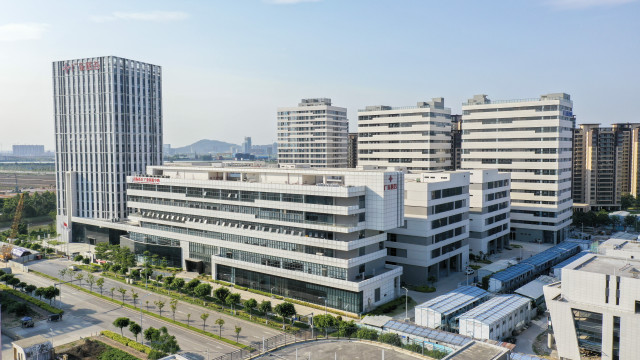05/11/2023 Source: newsgd.com
Share:
"The advanced manufacturing industry has become the key focus in the competition between countries. Guangdong will put more effort into upgrading its supply chains, boosting technological breakthroughs and the development of the services industry to achieve its high-quality development goal," Guo Wanda, Executive Vice President of China Development Institute (CDI), told GDToday in a recent interview.
Guo believes both domestic and foreign manufacturing companies face new opportunities as Guangdong, the economic powerhouse of China, stresses a shift in focus from quantitative economic indicators to sustainable and environmentally-friendly growth. He also highlighted the coordinated development trend in Guangdong for manufacturing enterprises that are of different sizes and business sectors.

Both domestic and foreign advanced manufacturers to see new chance in Guangdong
"Guangdong's OEM (Original Equipment Manufacturer) service took off 45 years ago, driving the province's foreign trade and overall development for years. Now that Guangdong's manufacturing industry has achieved leapfrog development, but it needs a qualitative breakthrough to drive further growth," said Guo.
To improve the quality of development, Guangdong highlights 20 strategic industrial clusters, among which eight have already exceeded 1 trillion RMB in output. These eight pillar industries include new-generation electronic information, green petrochemicals, intelligent home appliances, advanced materials, modern light industry and textiles, software and information services, modern agriculture and food, and automobiles.
Guo said Guangdong will bring new opportunities to the advanced manufacturing industry as the province plans more input into the weak links of its supply chains, including chips and semi-conductors, while it further strengthens the development of emerging industries such as bio-medicine, medical equipment and new materials.

(Guangdong Medical Valley/photo provided to GDToday)
In addition, Guo highlighted that technological breakthroughs are key in this process, which indicates the province will also put more input into labs and talent introduction. Now that AI and big data technologies can be applied to more and more business sectors, he anticipated that the system will be reformed and more open to interdisciplinary research and development.
Guo took the auto industry as an example: "the upstream and downstream suppliers could increase the quality and competitiveness of their products through pursuing high-quality development."

(Auto manufacturing in Guangzhou's Nansha/photo provided to GDToday)
The plan also indicates that Guangdong will establish 2-3 auto parts industrial parks with more than 100 billion RMB in output by 2025, which will benefit auto parts suppliers to increase the competitiveness of their products.
Guo considers the rise of unilateralism and anti-globalization harms the interests of both domestic and foreign companies. He believes foreign companies could share the opportunities and achieve further growth if they actively cooperate with their Guangdong partners in this trend of high-quality development.
Coordinated development to trigger technological spillover among Guangdong cities
When asked about the opportunities in the different cities, Guo highlighted that investors could pay attention to the plan for industrial upgrading in the five megalopolis areas of Guangdong. "The development of each megalopolis area is being accelerated with appropriate government guidance, convenient transportation networks, and the integrated development between cities," said Guo.

(The total length of Guangdong's expressway network has reached 11,211 km with the opening of 9 new highways since January 2023/photo provided to GDToday)
According to the Guangdong government, Guangdong classified its cities into five megalopolis areas in 2021. The Guangzhou metropolitan area includes Guangzhou, Foshan, Zhaoqing and Qingyuan. The Shenzhen metropolitan area includes Shenzhen-Shanwei Special Cooperation Zone, Dongguan, and Huizhou. The west coast of the Pearl River estuary metropolitan area includes Zhuhai, Zhongshan, and Jiangmen. And there are also the Shantou-Chaozhou-Jieyang metropolitan area and the Zhanjiang-Maoming metropolitan area.
Guo noted that these cities can be classified into three tiers in terms of the conditions of their manufacturing industries: the first-tier cities are Guangzhou and Shenzhen, where the manufacturing industry is mature; the second-tier cities are Zhongshan, Foshan, Dongguan, and Huizhou, where the manufacturing industry is also well-developed; the third-tier cities include Zhaoqing, Jiangmen, and Meizhou, where the manufacturing industry enjoys lower costs of production and has achieved rapid development in recent years.
"Improving the quality of industrial development in the first-tier cities can lead to technological spillover within the metropolitan area, which is expected to trigger the coordinated development of different metropolises," said Guo.
According to Guo's observation, eastern, western, and northern Guangdong cities are also worth investors' attention. "Guangdong will coordinate regional development through further construction of the province's transportation infrastructures and a unified market. Then cities such as Meizhou will also achieve rapid growth soon."
Author丨Jasmine, Nina
Poster丨Lulu
Editor丨Wing, Nan, James